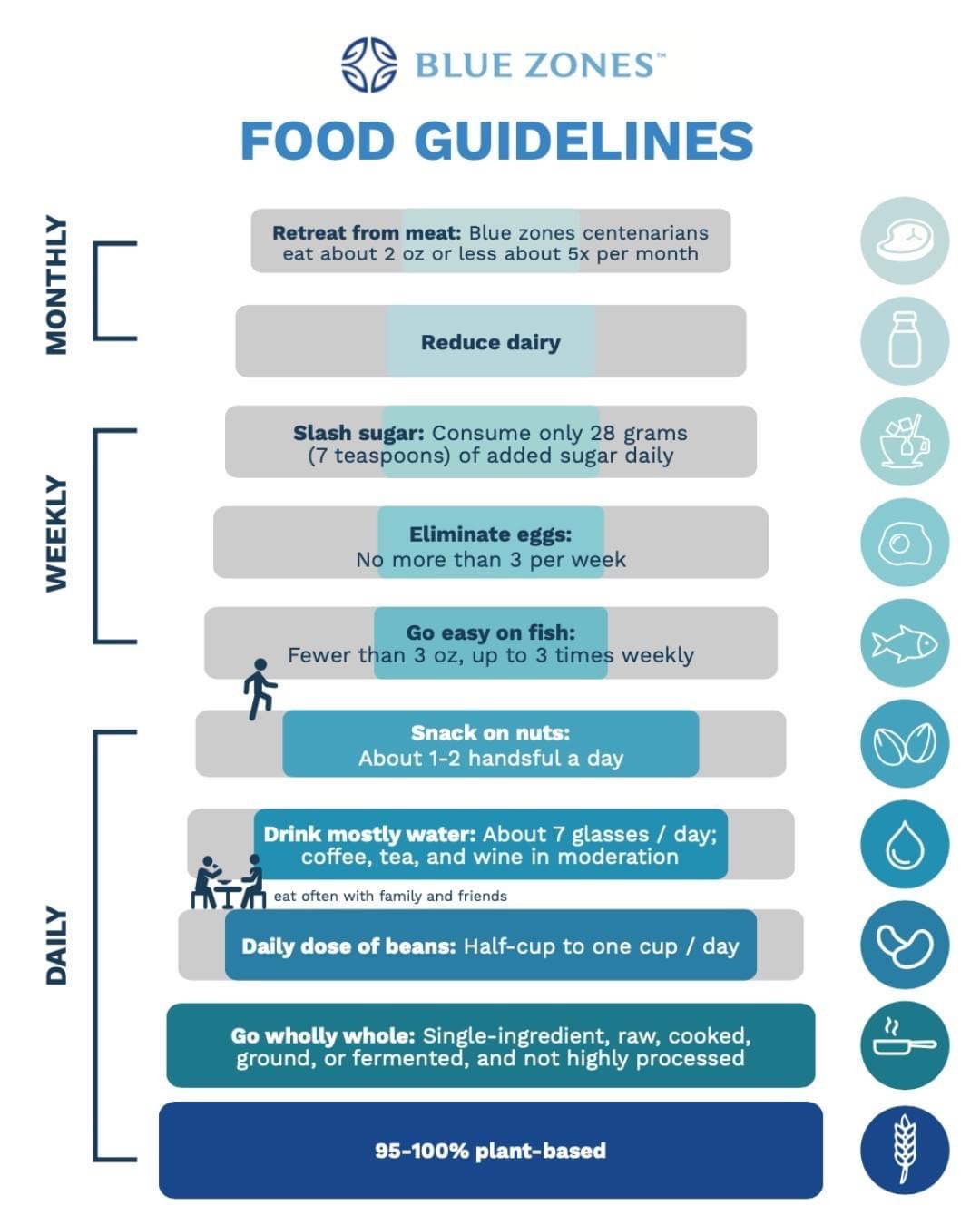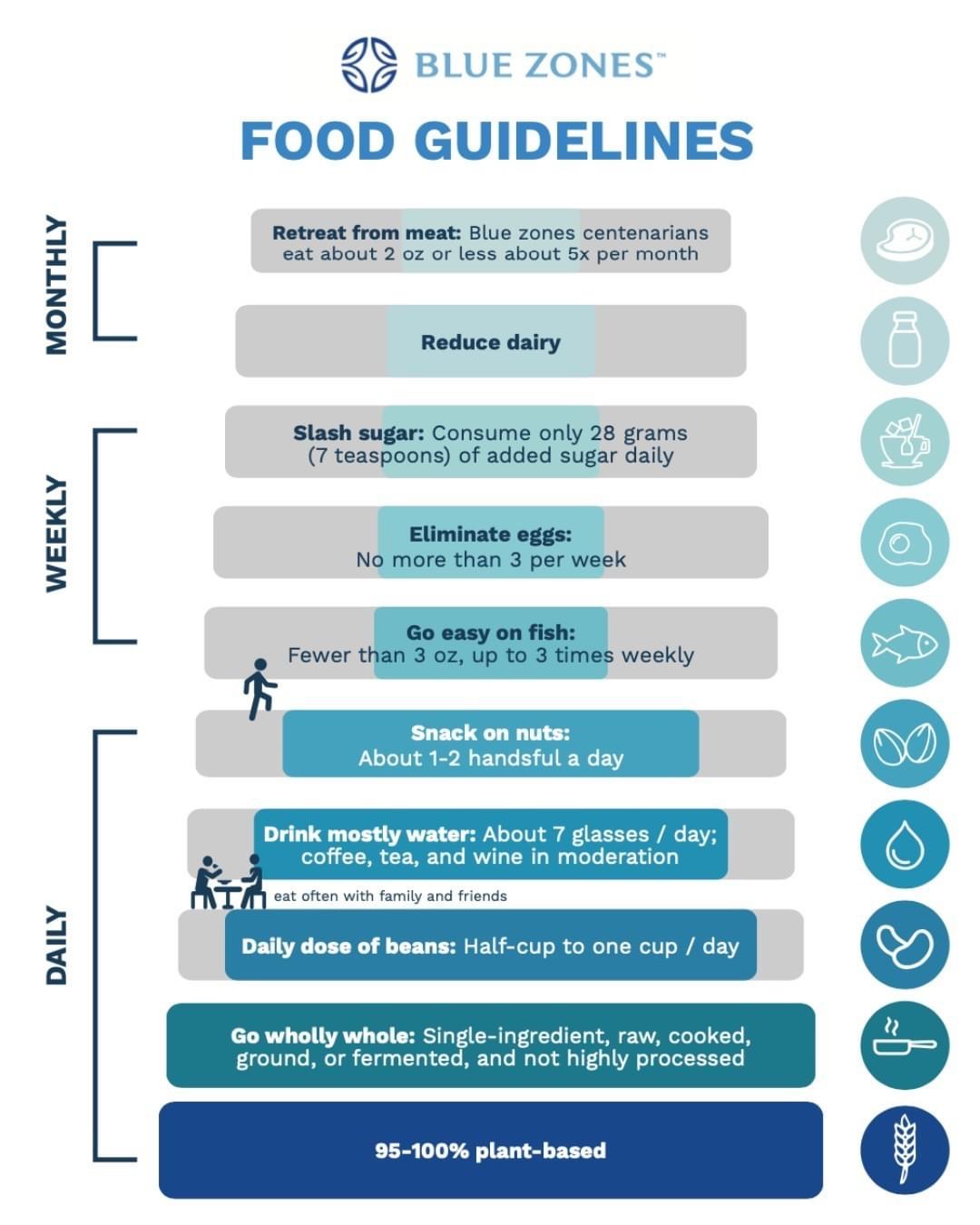I’m a big fan of The Blue Zones. The research is dense and goes back decades not to mention that it has the backing of The National Geographic Society. The issue for many people seems to be how to start and what are the simple steps. This morning’s email newsletter contained a simple daily, weekly and monthly routine that I want to share with you. In fact, the email encourages readers to save the image outlining the routine for better eating for longevity and health.
For those of you who have yet to watch the Netflix series, Live to 100 : Secrets of the Blue Zones, I encourage you to snuggle in with a cup of green tea and binge the four episodes. It’s remarkable and humbling to watch how 90+ year-olds go about their day. The work that they do, the foods that they eat, the social life that they maintain. It’s always so very interesting to watch how others live their lives but in this case, the day-to-day routine of their lives is not only keeping them alive longer but living healthier in their advanced years. We all want our senior years to be as healthy as possible, don’t we? Yet our society is riddled with barriers to achieving that goal disguised as choices to make our lives easier.
Our homes no longer have indulgent front porches where neighbours can sit and share news. OK, gossip, but social engagement is key. Our outdoor living space, increasingly smaller, has relocated to the back of our homes where fences and shrubs separate one neighbour from another. What remains of the front porch concept has been relegated to a small concrete pad atop four or five steps serving as nothing more than the front entry to the house. Not that the front porch is a destination any longer as we drive by those that exist in our car-centric world. We no longer walk to much of anything as the ‘burbs have been designed for housing density with the commercial areas situated outside of the housing and better accessible via highways and major roadways. In the town that I live in, the municipal council has decided that in the future sidewalks will only be on one side of every road to reduce maintenance costs, particularly in the winter, demonstrating the reduced importance of a place to stroll in modern town life.
Our grocery stores are stocked with prepared foods and with ‘fresh’ fruits and vegetables trucked in from many miles away. Chain stores have little autonomy to stock local produce when purchasing is centralized. Customers in rural areas have the ability to shop in local farmers markets and produce stands which is a good option for those who have automobiles and time to shop in multiple places. Those who don’t join their urban neighbours in having little access to truly fresh, seasonal food.

The new buzzword for food appears to be single-ingredient. A single-ingredient food is one that starts out and remains one single food. A potato, tomato, head of lettuce, rice or beans are good examples. Combined with only other single-ingredient foods in the making of a meal and avoiding processing is the key to maximizing nutrition while reducing sugars and other additives that add nothing of any nutritional value to our diets.
Beans. Let’s talk about beans for a moment. Inexpensive, easy to store and prepare and easy to use in multiple recipes. Blue Zones recommends eating half a cup to one cup each day. OK, let’s talk about the elephant in the room. Do beans make us gassy? Well, yes and no. Properly prepared and once they become a staple in your diet, your body becomes accustomed to the increased fibre that beans bring and as the body adjusts, the gassyness reduces. Beans are a common thread in the diets of those living in Blue Zones. Beans are added to salads, mixed with rice and mashed into other single-ingredient foods but always eaten daily.
As we snuggle in for the long winter and look for indoor hobbies, consider adopting some of the values in The Blue Zones food guidelines. Over the years we’ve published many articles on diets like the Mediterranean Diet, the MIND diet and other articles that discuss how various foods can affect our heart health, hearing, hot flashes and more. If you’d like to subscribe to The Blue Zones newsletter, click here. There’s a lot of information out there for those who are seeking simple ways to make substantial changes to our health and longevity.






Add Your Voice
0 Comments
Join the Discussion